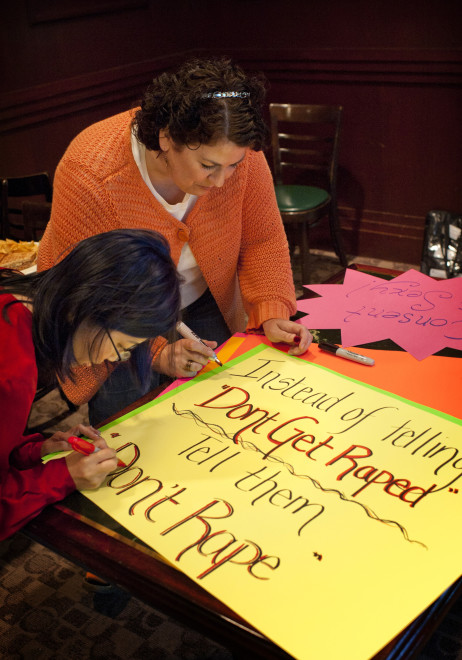Sexual Assault on Campus: Statistics, Definitions, and Culture

During our years at Washington University, we have listened to many of our friends describe instances of sexual assault that they have experienced at the hands of other Washington University students. Frequently, these cases are not clear-cut—one person may not intend to violate the other person; one or both of the individuals have been drinking; a verbal refusal at one point is followed by silence at a later time; physical and verbal cues seem to contradict each other; or the consent of one party is ambiguous in any number of other ways. The pervasiveness of “acquaintance rape” and the ambiguity of “consent” on our campus motivated us to investigate sexual assault at Washington University.
Lies, Damn Lies, and (Absent) Statistics?
The information we found was illuminating, but only after a lengthy and roundabout search. The data on sexual assault on our campus is limited, difficult to locate or gathered non-rigorously. The disappointing lack of statistics coupled with the absence of a sexual assault prevention coordinator on campus (until 2010) suggests that our community could afford to take this issue more seriously.
Moreover, many of the statistics that we did find on sexual assault at Washington University and on college campuses generally were inconsistent and confusing—using different terms, reaching different conclusions, and conducted in different years. The one statistic that remains unchallenged is that students on university campuses are at higher risk for sexual assault than their non-college peers. To illustrate the wide divergence in statistics, consider the following studies. A 2004 survey by the Washington University Committee on Sexual Assault, now called the Advisory Committee on Sexual Violence and Prevention, revealed that approximately one in five women and one in ten men have suffered rape or attempted rape by the time they left Washington University. In 2007, a survey of our student body conducted by the American College Health Association-National College Health Assessment found that 3.5% of women had suffered penetration or attempted penetration against their will over the past 12 months. And using a representative sample of more than 1000 female students nationally, some form of “unwanted sex” was experienced by over 50% of those questioned. Yet the widely reported national statistic for rape and attempted rape on college campuses is 15% and 12% respectively—or collectively one in four. The lack of consistent data is telling; it further confirms the ambiguity of cases of sexual assault on college campuses.
Redefining Categories of Sexual Assault
The issue of consent, and more specifically the ambiguity of consent, rests at the heart of these statistical puzzles—and the term plays a starring role in both Washington University’s and the state of Missouri’s definition of sexual assault. Put simply, if one party does not (or cannot) consent, a rights violation has occurred. Given the lack of precision in the above statistics and the inability of our current categorization to capture the nuances of sexual assault, we need an expanded vocabulary to describe instances of sexual assault that captures shades of consent. With this expanded set of terms, we can better understand ambiguous cases that may involve alcohol, an absence of a “yes” but a lack of a “no,” or a “no” without a physical rebuff.
In the spirit of obtaining a more finely tuned language set to describe acts of sexual assault, it is worth considering legal definitions of acts that result in death in order to introduce more precise definitions of sexual assault. In order to prove first-degree murder in a court of law, a prosecuting attorney must demonstrate the “premeditated intentional killing of another.” Manslaughter (or, depending on the state, involuntary manslaughter) is the unintentional, unpremeditated killing of another (e.g. inadvertently hitting someone with a car). Consequently, the two charges carry different penalties. In the case of manslaughter, we would never deny or discount the fact that a person is dead; the end state is the same as that of first-degree murder. Yet our society and courts recognize that intentionality matters and that punishment should be sensitive to this difference.
Although the murder-manslaughter analogy to sexual assault is far from perfect, when a sexual violation has been perpetrated unintentionally and without premeditation (perhaps as a result of the ambiguous consent of one of the parties), we should consider redefining its label. We should not ignore or belittle the violation in question. The consequence—a person has been violated—is the same regardless of the intention. But in certain cases we need not cast the perpetrator as an evil character, one who viciously violates others. And we need not label actors with the stigmatized term “rapist” or “victims” in all cases. A sexual assault equivalent of manslaughter—for instance “negligent sexual misconduct”—may be more fitting in particular instances on the Washington University campus.
This expanded vocabulary could have a variety of positive effects on campus, in addition to being beneficial in its increased precision. The first positive effect could be to increase the percentage of reported sexual assaults. In 2009, five rapes were reported at Washington University, down from seven rapes reported the year before. These numbers are in sharp tension with the often-cited national statistic of 15% mentioned above and even the Washington University statistic of 3.5% (which amounts to approximately 120 women out of an undergraduate population of 3,500 women). Since most college cases involve acquaintances rather than strangers, the decision to report a sexual assault would often require accusing friends or, at the very least, someone who will continue to be in your immediate campus environment. With the addition of “negligent sexual misconduct” as a possible category of sexual assault, people may be more likely to admit to themselves and to others that a sexual assault has occurred. Put simply, students may be more likely to report the incident.
The second positive effect would be that our discourse on sexual assault can stop dividing women and men immediately on the question of whether rape has actually occurred. You might remember your discussion after “The Date” during freshmen orientation. This absolute dichotomy – “rape” or “not rape”—works to the detriment of any productive engagement with the issue or with specific cases on campus. Therefore, if a less stigmatized category is introduced, men may be less inclined to instinctively become defensive.
Examining Culture and Sexual Pressures
In addition to reclassifying the categories of sexual assault, we also need to understand how cultural norms create an environment that allows for so much miscommunication concerning sexual assault. In other words, asking “why” is just as important as carefully categorizing and responding to an existing phenomenon.
Sexual assault deals with a violation of the normal conventions of sexual behavior. How do our expectations of what constitutes normal sexual behavior for men and women lead to such a toxic and stagnant discussion of finding the person at fault? Women are expected to be sexy, but not too sexy. They are expected to strike the perfect balance between “virgin” and “whore,” between mother and temptress. After all, women gain much of their social power from making use of their sexuality. The most popular girls in high school are often the ones who focus the most on their appearance and best use their looks to communicate status and power. Yet cross the forbidden line of too many boys or too little clothing, and a girl is instantly disrespected as loose or a slut. As Jackson Katz writes in It Takes a Village to Rape a Woman, “Young women [are] caught in this Catch-22 – where social validation comes from sexuality but the more sexual you act, the more you may be blamed –…[and they] are constantly negotiating an impossible balance, constantly concerned that admiration may change to contempt.”

While we may like to hold on to the comforting notion that things are different on our campus, they are not. You may do well on tests and participate in class, but you will still have to concern yourself with how low your dress should be on weekends. Imagine that you choose one night to wear that dress with the revealing décolletage. Now consider the 1995 study that reveals that, when faced with a scenario of sexual assault (between a man and a woman) and an accompanying photo of the woman dressed provocatively, respondents are more likely to judge the woman as responsible and the man’s actions as justified. When sexual assault occurs, women are often seen as “being a tease” or “asking for it.” And yet women are looked down upon for dressing too modestly.
Women face these complicated pressures when deciding whether to report sexual assault—and for men the situation is still more difficult. Why do we not talk about male victims of rape? As previously mentioned, in 2004 the Washington University Advisory Committee on Sexual Violence and Prevention found that one in ten men were survivors of rape or attempted rape. Yet on the rare occasions that this subject surfaces in discussion, we primarily limit it to a location clearly demarcated as outside the realm of normal society: prison. Men in prison are raped because they have no other choice; they cannot fight back. From this mindset springs the idea that outside such toxic environments, men should be able to fight back and defend themselves. According to Katherine Baker, “All rapes, in part, are about sex and masculinity and domination. But some…are predominantly about sex, some…are predominantly about masculinity, and some…are predominantly about domination.” Since men are supposed to be dominant and since sexual assault is fundamentally about powerlessness, the idea of being of a victim often leads to intense self-loathing, guilt, and shame. The social role of a “real man” is also often homophobic. Both gay and straight men are sexually assaulted, yet both are reluctant to report incidents because of the implicit connection society makes between sexual assault and sexual orientation.
A Way To Move Forward
If someone is accused of “negligent sexual misconduct,” perhaps the best solution is to require the accused and the accuser to meet separately with a professional counselor. Without diminishing the severity of the situation, this method would provide a more appropriate response to ambiguous cases of sexual assault than legal action. Of course, depending on the circumstances, the counselor may determine that the case is rape and report it to the authorities. Dealt with in-house and with discretion, this less punitive means to address certain cases of sexual assault could allow women and men to be less silent on the issue. We do not have all the answers, and our suggestions for Washington University are far from exhaustive. While you may disagree with our prescriptions, the status quo is unacceptable.